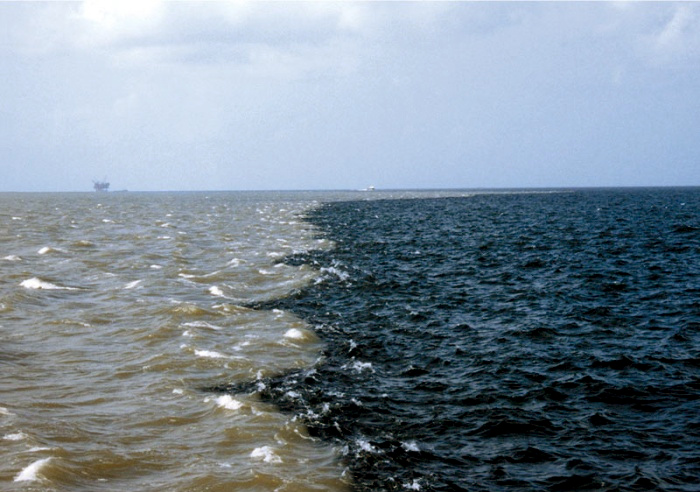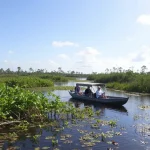Browsing:

The language “dead zone” stimulate sci-fi movie scenes of the Martian landscape or even the aftermath of the nuclear blast. Bleak places where existence is absent and things go bump at nighttime. Within the Gulf, a genuine dead zone exists, and also the suffocating effects towards the area’s occupants are as frightening like a horror film.
The Gulf dead zone is definitely an oxygen-starved area lacking on most marine existence. It’s from the Louisiana coast in which the Mississippi River empties in to the Gulf. In 2003, this killer swath of sea arrived at an archive size 8,492 square miles (22,079 sq km), bigger compared to condition of Massachusetts.
Periodic Phenomenon
The dead zone is really a periodic phenomenon that forms each spring as excess nutrients, mainly nitrogen, wash lower the Mississippi River and empty in to the Gulf. An overabundance of nitrogen energizes the development of phytoplankton (microscopic algae along with other plants) in the water’s surface. These phytoplankton produce oxygen, which remains close to the surface. The phytoplankton eventually die or are eaten by floating, frequently microscopic creatures. The byproducts (dead plant matter and fecal waste) out of this plentiful feast fall towards the sea floor where they’re consumed by bacteria. As colonies of bacteria feed, they deplete oxygen in the sea bottom.
This isn’t always an issue as lengthy as oxygen-wealthy surface water can achieve and replenish the oxygen-deprived bottom water. However in late spring and early summer time, storm frequency decreases, leading to calmer water. Additionally, surface temperatures rise. And also the light warm freshwater flowing in to the gulf in the Mississippi forms another layer over the heavier, cooler brine. Without significant storms to churn the layers together, the foot of the gulf has oxygen levels lacking to aid marine existence — an ailment known as “hypoxia.”
At first glance, hypoxic waters can be displayed normal, however the bottom is eerily lacking associated with a living animal and full of the casualties of suffocation. In extraordinary instances, the sediment turns black.
Fish can go swimming from the hypoxic waters, or dead zone, to areas with existence-sustaining oxygen levels, but other marine creatures for example mollusks, anemones and worms cannot and die. Hypoxic waters kill high amounts of marine species, disrupting the meals chain and habitat. Additionally to wreaking environmental havoc, the dead zone could be a financial drain on seaside communities. Alterations in the distribution of fish, shrimp and oyster beds can result in economic losses for that Gulf of Mexico’s multibillion dollar sea food industry. And recreational fishermen go elsewhere, taking their wallets together.
Hypoxia affects most of the world’s seaside areas including Chesapeake Bay, and also the Baltic and Black seas. However the Gulf dead zone supports the unfortunate title from the largest section of oxygen-depleted seaside water within the U . s . States and also the entire western Atlantic. The dead zone varies in dimensions each year based on river flow, wind along with other ecological factors, however it has elevated since 1985 when scientists first started taking regular measurements. Since 1993, it’s exceeded almost 4,000 square miles (10,400 sq km). The dead zone reaches its peak at the begining of summer time, and it is damaged in late August or September by cooler surface temperatures and tropical storms or hurricanes.
Foul Waters
The main offender accountable for the growing size the dead zone is definitely an growing way to obtain nitrogen dumped in to the Gulf in the Mississippi River. Nitrogen levels discharged in the river have nearly tripled because the 1950s, by having an annual average since 1980 of just one.six million metric tons. Causes of nitrogen include fertilizers, animal manure, sewage runoff, industrial waste and atmospheric pollutants.
The Mississippi River basin, at 1.two million square miles (3.a million sq km), may be the largest river basin in The United States and also the third-largest on the planet. It offers 40 % from the U . s . States, drains 30 states, and hosts 70 million people or nearly one-quarter from the country’s population. It extends in the Appalachian towards the Rocky mountain tops, and from southern Canada towards the Gulf. Nearly all all farming chemicals utilized in the U . s . States are dumped around the Mississippi River basin’s cropland, which comprises 58 percent from the area. Based on a U.S. Geological Survey study, over fifty percent from the nitrogen entering the gulf in the Mississippi seems in the future from farming sources. Lands in southern Minnesota, Iowa, Illinois, Indiana and Ohio lead the majority of the basin’s nitrogen.
Taming a River
Additionally to elevated nitrogen levels in the Mississippi River basin, additional factors lead towards the dead zone. Before humans tinkered using the mighty Mississippi so that they can control flooding, the forest had the opportunity to spill over its banks if this got too full. The surplus water would seep into belts of natural plant life across the river, known as riparian zones, and into wetlands. Both riparian zones and wetlands behave as filters, cleansing ton water of excess nutrients.
Landscape alterations in the basin have hampered the river’s capability to rid itself of excess nutrients. The forest continues to be diverted, straightened and levied in lots of places. Also, the majority of the original freshwater wetlands and riparian zones within the basin have left. Ohio, Indiana, Illinois and Iowa have drained greater than 80 % of the wetlands. Indiana, Illinois, Iowa, Minnesota, Missouri and Wisconsin with each other have forfeit 35 million acres of wetlands in the last two centuries.
Lowering the Dead Zone
Can the Gulf dead zone be eliminated? Most likely not, because of the country’s current quality lifestyle using its associated types of pollution — fertilizers, pesticides, sewage, industrial waste, etc. But based on an Ecological Protection Agency plan of action produced by the Mississippi River/Gulf Watershed Nutrient Task Pressure, the dead zone could be reduced.
The program is the effect of a multiyear study the dead zone conducted by leading scientists within the field. A significant objective of the program would be to reduce how big the dead zone to under 1,930 square miles (5,018 sq km), or about 50 % from the average through the year 2015. The easiest method to make this happen would be to lessen the levels of nutrients, particularly nitrogen, entering the gulf in the Mississippi River. A 20 % to 30 % decrease in nitrogen might be necessary to possess a significant positive impact on marine existence. Along with a 40 % reduction is needed to come back nitrogen levels to individuals during 1955-1970 when hypoxia was a lesser problem.
In writing, the program sounds simple. Used, significant changes will have to occur. A mix of activities is going to be necessary, including reducing fertilizer experience farms, creating wetlands and riparian zones near streams to absorb excess nitrogen, and reducing discharges from sewage treatment and industrial plants. How big the dead zone each year will indicate if the plan works.
Making the bond
The dead zone is, partly, caused by human-caused factors. It’s also proof that things are connected — a Minnesota farm along with a Wisconsin sewage plant can impact marine existence a 1000 miles away. Within the horror movies, people flee from killer forces or interact to combat them. Within the situation from the Gulf dead zone, the selection is obvious.
At first glance, hypoxic waters can be displayed normal, however the bottom is eerily lacking associated with a living animal and full of the casualties of suffocation. In extraordinary instances, the sediment turns black.
Sources To understand more about the Gulf dead zone, visit:
Science Museum of Minnesota:
Site: www.smm.org/deadzone/top.html
Ecological Protection Agency:
Site: www.environmental protection agency.gov/msbasin/hypoxia.htm
National Oceanic and Atmospheric Administration:
Site: www.nos.noaa.gov/products/pubs_hypox.html
By Amy Gulick
Resourse: https://dtmag.com/thelibrary/no-oxygen-no-existence-gulf-mexicos-dead-zone/
Gulf of Mexico's Dead Zone Growing Again
COMMENTS:
Joe Mamma: yabba do




